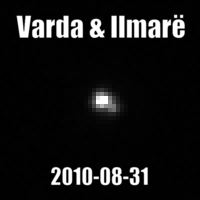 Hubble Space Telescope image of Varda and its satellite Ilmarë, taken in 2010 and 2011 | |
| Discovery[1][2][3] | |
|---|---|
| Discovered by | J. A. Larsen |
| Discovery site | Kitt Peak National Obs. |
| Discovery date | 21 June 2003 |
| Designations | |
Designation | (174567) Varda |
| Pronunciation | /ˈvɑːrdə/ |
Named after | Varda (figure by J. R. R. Tolkien)[2] |
| 2003 MW12 | |
| TNO[1] · cubewano[4] detached[5] · distant[2] | |
| Symbol | |
| Orbital characteristics[1] | |
| Epoch 31 May 2020 (JD 2459000.5) | |
| Uncertainty parameter 2 | |
| Observation arc | 39.12 yr (14,290 d) |
| Earliest precovery date | 19 March 1980 |
| Aphelion | 52.711 AU |
| Perihelion | 39.510 AU |
| 46.110 AU | |
| Eccentricity | 0.14315 |
| 313.12 yr (114,366 d) | |
| 275.208° | |
| 0° 0m 11.332s / day | |
| Inclination | 21.511° |
| 184.151° | |
| ≈ 1 November 2096[6] ±4 days | |
| 180.072° | |
| Known satellites | 1 (Ilmarë) |
| Physical characteristics | |
| 740±14 km (area equivalent)[7] 722+82 −76 km[a][8] | |
| Flattening | 0.080±0.049 (for period of 11.82 h)[7] or 0.235±0.050 (for period of 5.91 h)[7] |
| Mass | (2.45±0.06)×1020 kg[7][b] |
Mean density | 1.23±0.04 g/cm3 (for period of 11.82 h)[7] 1.78±0.06 g/cm3 (for period of 5.61 h)[7] |
| 5.61 h[8] or 5.91 h (single-peaked)[9] 11.82 h (double-peaked)[9] | |
| Albedo | 0.099±0.002 (primary)[7] 0.102+0.024 −0.024[10] |
Spectral type | IR (moderately red)[8] B−V=0.886±0.025[8] V–R=0.55±0.02[11] V−I=1.156±0.029[8] |
| 20.5[12] | |
| 3.81±0.01 (primary)[7] 3.097±0.060[8] 3.4[1] | |
174567 Varda (provisional designation 2003 MW12) is a binary trans-Neptunian planetoid of the resonant hot classical population of the Kuiper belt, located in the outermost region of the Solar System.[1] Its moon, Ilmarë, was discovered in 2009.[13]
Astronomer Michael Brown estimates that, with an absolute magnitude of 3.5 and a calculated diameter of approximately 700–800 kilometers (430–500 miles),[14][15] it is likely a dwarf planet.[16] However, William M. Grundy et al. argue that objects in the size range of 400–1000 km, with albedos less than ≈0.2 and densities of ≈1.2 g/cm3 or less, have likely never compressed into fully solid bodies, let alone differentiated, and so are highly unlikely to be dwarf planets.[17] It is not clear if Varda has a low or a high density.
- ^ a b c d e Cite error: The named reference
jpldatawas invoked but never defined (see the help page). - ^ a b c Cite error: The named reference
MPC-objectwas invoked but never defined (see the help page). - ^ Cite error: The named reference
MPC-TNO-listwas invoked but never defined (see the help page). - ^ Cite error: The named reference
MPEC 2009-C70was invoked but never defined (see the help page). - ^ Cite error: The named reference
Buiewas invoked but never defined (see the help page). - ^ JPL Horizons Observer Location: @sun (Perihelion occurs when deldot changes from negative to positive. Uncertainty in time of perihelion is 3-sigma.)
- ^ a b c d e f g h Cite error: The named reference
Souami2020was invoked but never defined (see the help page). - ^ a b c d e f g Cite error: The named reference
Grundy-2015was invoked but never defined (see the help page). - ^ a b Cite error: The named reference
Thirouin-2014was invoked but never defined (see the help page). - ^ Cite error: The named reference
TNOsCool-10was invoked but never defined (see the help page). - ^ Cite error: The named reference
Tegler-2016was invoked but never defined (see the help page). - ^ Cite error: The named reference
AstDyswas invoked but never defined (see the help page). - ^ Cite error: The named reference
johnstonsarchivewas invoked but never defined (see the help page). - ^ Cite error: The named reference
Maley2018was invoked but never defined (see the help page). - ^ Cite error: The named reference
EPSC-DPS2019-1076was invoked but never defined (see the help page). - ^ Cite error: The named reference
Brown-dplistwas invoked but never defined (see the help page). - ^ W.M. Grundy, K.S. Noll, M.W. Buie, S.D. Benecchi, D. Ragozzine & H.G. Roe, 'The Mutual Orbit, Mass, and Density of Transneptunian Binary Gǃkúnǁʼhòmdímà ((229762) 2007 UK126)', Icarus (forthcoming, available online 30 March 2019) Archived 7 April 2019 at the Wayback Machine DOI: 10.1016/j.icarus.2018.12.037,
Cite error: There are <ref group=lower-alpha> tags or {{efn}} templates on this page, but the references will not show without a {{reflist|group=lower-alpha}} template or {{notelist}} template (see the help page).